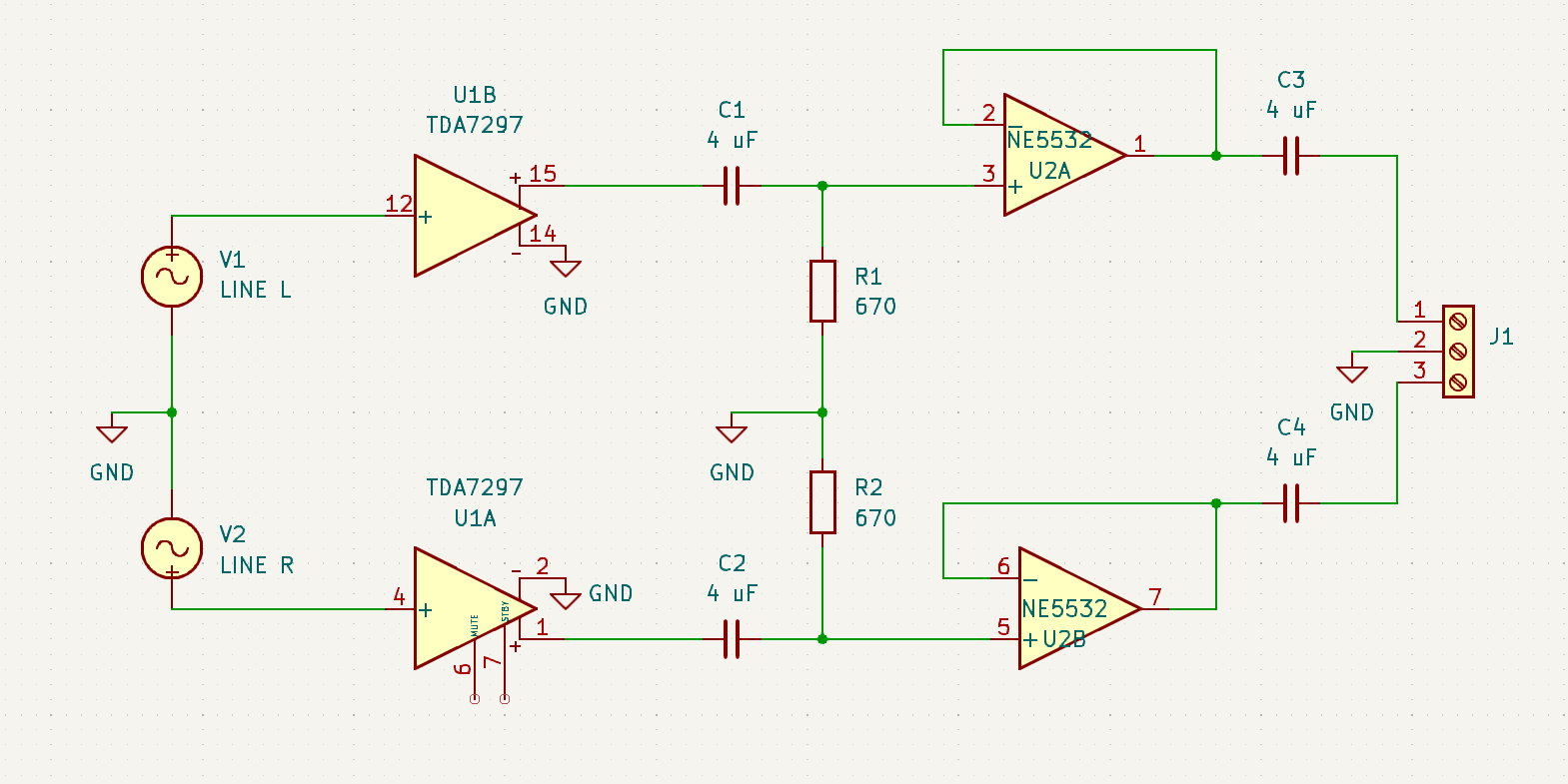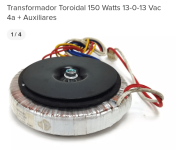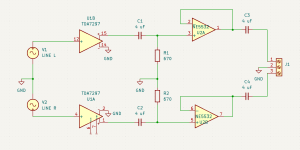Update 1: The high pass is not for noise, it's for the ported full range speaker.
Update 2: As @diyMartin points out, the NE5532 won't drive a speaker. I put it as a placeholder but it's misleading.
Update 3: Also thanks for pointing out that the neg output of the TDA7297 cannot be grounded as I did in the sketch.
Hello there.
I have been trying class A/B amps and a tone preamp.
I took the noise out of the TDA7850 with a capacitance multiplier.

I ran the preamp with a battery after replacing the ICs with ones I know are original, still have to check the ones I got with it.

Both work now if the source is a phone. But... They don't like a desktop computer or laptop with a charger.
.....
The TDA7297, connected to a switching power supply, and to the desktop computer, doesn't care. Zero hum. I love how it sounds, I only use a few watts. A TPA3116d2 I have doesn't produce hum either in this setup.

I recently got a toroidal transformer with auxiliary outputs, so I could run a TDA7297 and another amp without sharing the same transformer output lines. So, two questions:
1) If I use separated outputs from the toroidal transformer, can I run an amp after a TDA7297 board like the one I have above with little gain so that I can reject line noise? The ground is still shared... The NE5532 is a placeholder, I would put another amp with some gain.
2) Is a 60Hz high pass like this one OK here? assuming the amp to feed has input impedance > 10k Ohm.
I power a pair of 8ohm full range speaker and I don't use more than a few watts. This is the idea, not an exact schematic...

I got a scope and I hope it help me debug issues... Not there yet, learning. BTW, the house electricity is not good, it's 130V and it doesn't have ground, online L and N.
Update 2: As @diyMartin points out, the NE5532 won't drive a speaker. I put it as a placeholder but it's misleading.
Update 3: Also thanks for pointing out that the neg output of the TDA7297 cannot be grounded as I did in the sketch.
Hello there.
I have been trying class A/B amps and a tone preamp.
I took the noise out of the TDA7850 with a capacitance multiplier.
I ran the preamp with a battery after replacing the ICs with ones I know are original, still have to check the ones I got with it.
Both work now if the source is a phone. But... They don't like a desktop computer or laptop with a charger.
.....
The TDA7297, connected to a switching power supply, and to the desktop computer, doesn't care. Zero hum. I love how it sounds, I only use a few watts. A TPA3116d2 I have doesn't produce hum either in this setup.
I recently got a toroidal transformer with auxiliary outputs, so I could run a TDA7297 and another amp without sharing the same transformer output lines. So, two questions:
1) If I use separated outputs from the toroidal transformer, can I run an amp after a TDA7297 board like the one I have above with little gain so that I can reject line noise? The ground is still shared... The NE5532 is a placeholder, I would put another amp with some gain.
2) Is a 60Hz high pass like this one OK here? assuming the amp to feed has input impedance > 10k Ohm.
I power a pair of 8ohm full range speaker and I don't use more than a few watts. This is the idea, not an exact schematic...
I got a scope and I hope it help me debug issues... Not there yet, learning. BTW, the house electricity is not good, it's 130V and it doesn't have ground, online L and N.
Attachments
Last edited:
Some quick comments:
- Connecting the negative output of the TDA7297 to ground is short-circuiting the negative output amp: No go
- Using a normal opamp (no mattter if it is a ne5532 or other) AFTER the power amplifier makes no sense.
Doing so will require the opamp to drive the speakers directly - and that will give you a very hot opamp and only a few mW to the speakers.
- The 4uF output capacitors will give a lower -3dB frequency of almost 5KHz with an 8Ohm speaker if you tried - putting you in pure "treble-land".
- Having a 60Hz filter will only reduce 60Hz hum by 3dB. That is almost nothing (BTW: 670 Ohms is not a standard value)
- Have you actually checked that the hum is 60Hz? - it may be 120Hz if it originates from the power supply.
My best (and short guess) is that you are suffering from ground issues between the laptop PSU and the amplifier.
- Connecting the negative output of the TDA7297 to ground is short-circuiting the negative output amp: No go
- Using a normal opamp (no mattter if it is a ne5532 or other) AFTER the power amplifier makes no sense.
Doing so will require the opamp to drive the speakers directly - and that will give you a very hot opamp and only a few mW to the speakers.
- The 4uF output capacitors will give a lower -3dB frequency of almost 5KHz with an 8Ohm speaker if you tried - putting you in pure "treble-land".
- Having a 60Hz filter will only reduce 60Hz hum by 3dB. That is almost nothing (BTW: 670 Ohms is not a standard value)
- Have you actually checked that the hum is 60Hz? - it may be 120Hz if it originates from the power supply.
My best (and short guess) is that you are suffering from ground issues between the laptop PSU and the amplifier.
- Connecting the negative output of the TDA7297 to ground is short-circuiting the negative output amp: No go
Oh! Great. That's good news, that the output is not connected to ground.
- Using a normal opamp (no mattter if it is a ne5532 or other) AFTER the power amplifier makes no sense.
Doing so will require the opamp to drive the speakers directly - and that will give you a very hot opamp and only a few mW to the speakers.
Thanks. It was a placeholder, a real amp should go there. Next time I'll add some text or another symbol.
- The 4uF output capacitors will give a lower -3dB frequency of almost 5KHz with an 8Ohm speaker if you tried - putting you in pure "treble-land".
But it is not for 8 Ohm, it's for the input impedance of the next amplifier. If the input impedance of the next amp is 10k ohm then the actual resistance would be about 636... I hope it's higher. Right?
- Having a 60Hz filter will only reduce 60Hz hum by 3dB. That is almost nothing (BTW: 670 Ohms is not a standard value)
I should have said it's not for the noise, it's to help with over-excursion in a vented setup.
- Have you actually checked that the hum is 60Hz? - it may be 120Hz if it originates from the power supply.
I'll check soon. The board with the TDA7850 in the question above doesn't like the desktop PC at all so not using it right now.
The amp I was using yesterday was the following board with TDA7377, it was OK but from the 4 units I am using only 2 and I don't get much output even with full volume, I have to increase the input volume in the source above 0dB even if using 18v.
So with this new board:
- No noise with switching power supply and connected to desktop PC. Only low volume that can be fixed by increasing the input level above 0dB.
- Lots of noise when I put the preamp powered by a battery in the middle, I tried different gains.
- Then I powered the AMP with a 5000mAh 12V Lipo batt and quieter, but the noise was still unbearable! Hum. Preamp with a battery and Amp with another one.
So, the input seems to be the source with this last test... With a battery less noise but still bad noise from the PC, not from the phone.
I'll check the frequency.
Last edited:
Where do you connect the speakers?
I assumed that C3 and C4 was the output capacitors connecting the speakers through J1.
And I still do not understand why you would place an amplifier after the power amplifier - it makes limited sense to use a power amplifier just to drive a line signal.
If your intention is just to add a 6dB/oct high pass filter to limit speaker excursion, then a simple RC filter at the input of the power amplifier would work - and that is already described in the application diagram by the vendor.
The recommended (source: datasheet from STMicroelectronics) input capacitor of 0.22 uF will give a cutoff at around 24Hz - so something like 82-100nF instead would give you a lower cutoff at around 60Hz.
I assumed that C3 and C4 was the output capacitors connecting the speakers through J1.
And I still do not understand why you would place an amplifier after the power amplifier - it makes limited sense to use a power amplifier just to drive a line signal.
If your intention is just to add a 6dB/oct high pass filter to limit speaker excursion, then a simple RC filter at the input of the power amplifier would work - and that is already described in the application diagram by the vendor.
The recommended (source: datasheet from STMicroelectronics) input capacitor of 0.22 uF will give a cutoff at around 24Hz - so something like 82-100nF instead would give you a lower cutoff at around 60Hz.
- Have you actually checked that the hum is 60Hz? - it may be 120Hz if it originates from the power supply.
Not good, this happens if I disconnect the tip of the probe and place it parallel to the cable. It seems the cable is not shielded, I need to get better cables to see how things improve. I will probably get noise anyway but hopefully less. There is no ground and I have a UPS.
First time I use the scope 🙂 I couldn't get a good FFT, I need to check the manual.
I assumed that C3 and C4 was the output capacitors connecting the speakers through J1.
Sorry, I meant other amplifier. In this case it would be a preamp that picks up noise easily, and then a power amp. Please see what I'm writing next.
And I still do not understand why you would place an amplifier after the power amplifier - it makes limited sense to use a power amplifier just to drive a line signal.
Yeah, it seems I had a hard time asking the right thing and got lost in the details. A hack to get rid of the noise for a high-impedance stage that has a separate and hopefully clean power supply, say battery or capacitance multiplier with linear regulation.
Too much of a hack? 🧐
If I understood correctly what I read, with headroom if the TDA7297 it is not putting out much (say 2X the line level) then there is not much distortion.
The recommended (source: datasheet from STMicroelectronics) input capacitor of 0.22 uF will give a cutoff at around 24Hz - so something like 82-100nF instead would give you a lower cutoff at around 60Hz.
Thanks, I need to get the capacitors. I do have 4uF for audio but not 100nF.
OTOH I read that the resistances offer a path for some noise. That's why I thought I would do the high pass in that way...
7297
What makes the 7297 board I have resilient to the electrical noise I'm experiencing with other A/B amps and that I also measured?
Is it a feature of the chip or the passive components?
It's the typical Chinese board.
Edit: The noise is in the input signal.
- Home
- Amplifiers
- Chip Amps
- Chip Amp before another amp for noise reduction?

